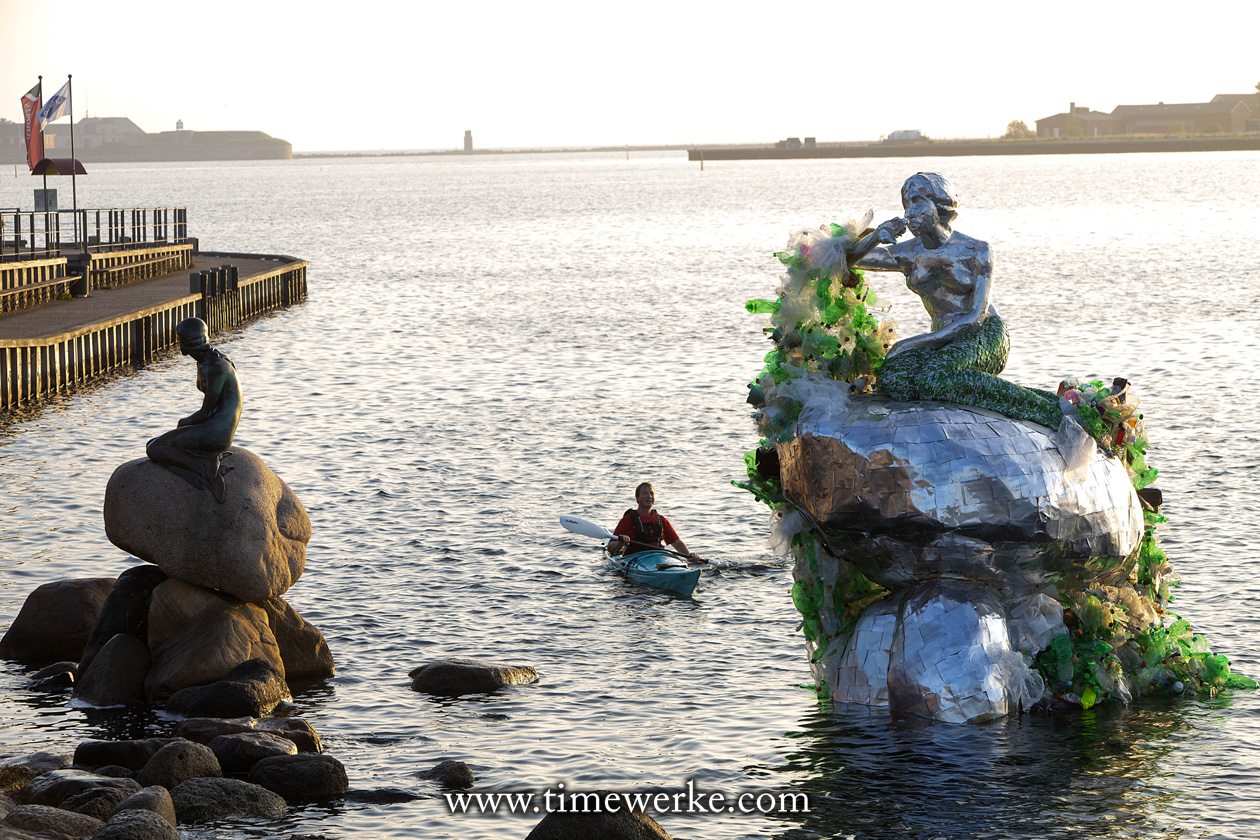
The Little Mermaid on the left, standing at 1.25 metres tall, at the Langelinje Pier in Copenhagen, Denmark. The bronze statue was a gift to the city of Copenhagen from Carl Jacobsen, son of Jacob Christian Jacobsen who founded the Danish brewery Carlsberg. On its right was its its three-metre tall Little Mermaid “sibling” commissioned by Carlsberg and made of the Danish brewer’s “Snap Pack” cans which do not require the use of plastic when packaged as a six-pack. Carlsberg claims that its new packaging with Snap Pack cans will reduce 1,200 tonnes of plastic waste annually. The “Snap Pack” little mermaid “canstruction” is on display at the Carlsberg Visitor Centre in Copenhagen. Photo: Carlsberg.Photo: Ole Jensen/ Getty Images for Carlsberg.
Remember classic children’s stories such as The Little Mermaid (published in 1837), The Emperor’s New Clothes (1837) and The Ugly Duckling (1843)?
They were written by the well-known Danish author Hans Christian Andersen (1805 to 1875) whose stories have inspired cartoons and even Hollywood movies.
The Little Mermaid animated musical movie that was produced by Walt Disney Feature Animation and released in 1989 is one example.
On 17 August 2018, The Little Mermaid fantasy adventure movie which stars Poppy Drayton as the memaid was released.
The Little Mermaid statue is even a tourist attraction in Hans Christian Andersen’s country of birth. This famous statue that is located at Langelinje Pier in Copenhagen, Denmark is what the Statue of Liberty is to New York or what the Eiffel Tower is to Paris.
Unveiled on 23 August 1913, this bronze and granite sculpture was a gift to the city of Copenhagen from Carl Jacobsen, son of Jacob Christian Jacobsen who founded the Danish brewery Carlsberg in 1847.
The 1.25-metre tall bronze mermaid sculpture on a rock was sculpted by Edvard Eriksen.
On 6 September 2018, Carlsberg presented another “little mermaid” not as a gift, but as a symbol of environmental conservation.
This Little Mermaid is made from what the Danish brewer terms the “Snap Pack” cans, its packaging innovation that does not require the use of any plastic wrapping for its six-packs.
Carlsberg even claims that the new packaging with Snap Pack cans will reduce 1,200 tonnes of plastic waste annually.
The Snap Pack cans are held together by glue allowing beer drinkers to “snap” an individual can off the six-pack, pull the tab off and enjoy their brew.
Video: Carlsberg.
The three-metre “canstruction” as described by Carlsberg, “… features a rising tide of 137 kilograms of plastic – representative of the amount of plastic that Carlsberg will be eliminating every year”, adding that their packaging innovation will reduce the amount of plastic used in traditional multipacks by up to 76%.
Now for those who visit The Little Mermaid at Langelinje Pier but don’t see the “Snap Pack” little mermaid “canstruction”, fret not, for it has been on display since 7 September 2018 at the Carlsberg Visitor Centre in Copenhagen.
While the 1,200 tonnnes plastic waste reduction represents a tiny fraction of the eight million metric tonnes of plastic that is thrown into our oceans every year, it is still commendable as it is a positive step in the right direction.
If nothing is done to control and reduce plastic waste today, especially those that end up in our seas, there will be more plastic by weight in the oceans than there are fish by 2050, according to Earth Day, Fact #5.
Therefore, we wholeheartedly drink to this “Snap Pack” Little Mermaid’s cheers.
Speaking of cheers, did you know that “cheers” is one of the top 20 ways to say “thank you”? This is the conclusion from a poll of 3,000 people according to the article “Britons abandon ‘thank you’ in favour of ‘cheers’” written by Murray Wardrop and published in The Telegraph.
Well, for Carlsberg’s efforts to help our environment by reducing the use of plastic, we’ll also like to say “Cheers!”
For more on plastic thrash in our oceans and how it affects us, we recommend viewing the video: How Our Plastic Thrash Become Plastic Bullets on our TimeWerke Videos channel.
